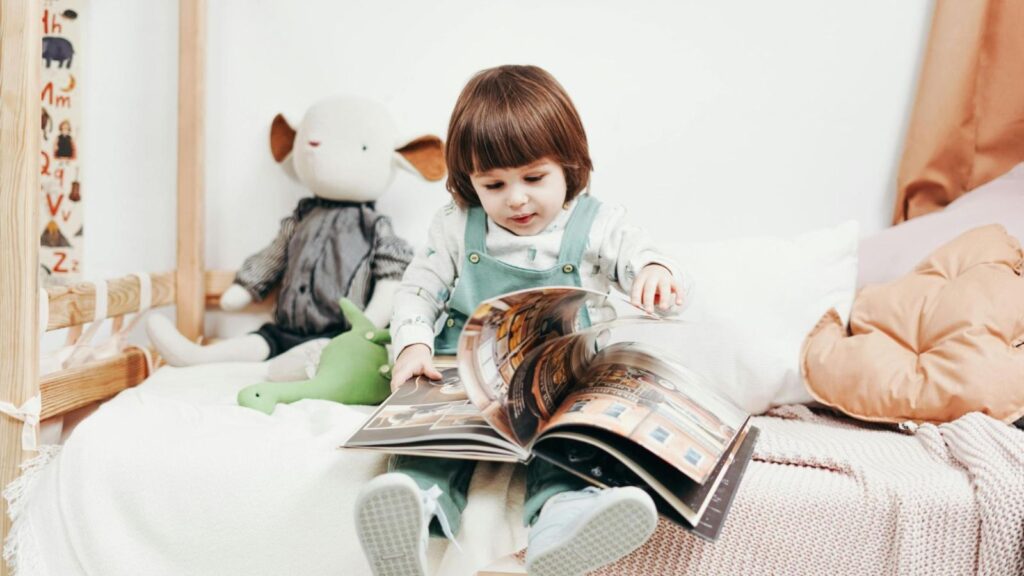Introduction
If you’re a parent of a toddler, you’re no stranger to the seemingly never-ending cycle of bedtime battles. The days of dinnertime debates and tantrums at bedtime can sometimes feel as relentless as a rollercoaster ride. Yet, hope is on the horizon—a revolution in toddler sleep transforming those nightly struggles into peaceful, restorative moments for children and parents alike. In this article, we’re diving deep into the toddler sleep revolution, exploring why sleep is essential for your little one, and sharing practical, research-backed strategies to turn bedtime battles into blissful routines. So, grab your favorite cup of tea (or coffee), settle in, and embark on this journey to reclaim your evenings and transform your toddler’s sleep experience.
The Importance Of Toddler Sleep: More Than Just Rest
Sleep is the foundation upon which healthy growth, learning, and emotional regulation are built, especially during the toddler years. Toddlers are busy little beings—absorbing, exploring, and learning every minute of their day. Amidst all this excitement, quality sleep provides a critical period for their bodies and brains to recover, grow, and process the day’s experiences.
Why Sleep Matters
Brain Development and Cognitive Function:
During sleep, a toddler’s brain consolidates new information, bolsters memory, and strengthens neural connections crucial for learning. This rest period isn’t simply about recharging; it’s an active, dynamic phase where the brain processes and organizes information acquired throughout the day.
Emotional Regulation:
A well-rested toddler is better equipped to manage emotions. When sleep-deprived, even the smallest frustrations can lead to big meltdowns. Adequate sleep helps foster a calmer, more balanced emotional state, reducing anxiety, irritability, and impulsiveness.
Physical Growth And Immune Function:
Growth hormones are primarily secreted during deep sleep. This is when your toddler’s body is busy growing muscles, bones, and tissues. Additionally, regular sleep bolsters the immune system, ensuring your little one stays healthy and active.
Family Harmony
When your toddler gets sufficient sleep, everyone in the family benefits. Parents enjoy more peaceful evenings and a sense of control over the day’s routines, and the household experiences lower stress levels.
Common Bedtime Battles: Why Do They Happen?
Understanding why bedtime battles occur is the first step toward resolving them. Let’s look at some common scenarios:
The Reluctant Bedtime
Fear of Missing Out (FOMO):
Toddlers are naturally curious. As they see the world outside their room, being confined to a bed might feel restrictive, leading to resistance.
Separation Anxiety
Many toddlers experience anxiety when separated from their caregivers, especially at bedtime. This anxiety can manifest as protests and crying, making the bedtime transition challenging.
Overstimulation And Over-Tiredness
Too Much Energy
Sometimes, toddlers are too wound up from a day full of activities. If they don’t wind down properly, their energy can backfire at bedtime, resulting in restless behavior and difficulty falling asleep.
Inconsistent Routines
Inconsistent bedtime routines or erratic schedules can confuse toddlers, making it harder for them to settle down. A predictable routine is key to setting the stage for sleep.
Environmental Distractions
Noisy or Uncomfortable Sleep Environments:
External factors like bright lights, loud noises, or an uncomfortable bed can all contribute to sleep disturbances. Ensuring a soothing and secure sleep space is crucial.
Technological Interference
In our modern world, screens and electronic devices can disrupt a toddler’s sleep cycle. Limiting screen time before bed is an important part of the sleep revolution.

Strategies For Turning Bedtime Battles Into Bliss
Now that we understand the challenges, let’s explore some actionable strategies that have emerged from this toddler sleep revolution. These tips are designed to transform the bedtime experience into a peaceful, predictable, and even enjoyable routine for both toddlers and parents.
Establish A Consistent, Soothing Routine
Consistency is the cornerstone of effective sleep training. Creating a predictable bedtime ritual helps signal your toddler that it’s time to wind down. Consider incorporating the following elements:
Calming Activities
Engage in quiet, soothing activities such as reading a favorite book, gentle cuddling, or playing soft music. These activities help transition the mind and body from active play to relaxation.
Routine Steps
Design a sequence of steps that are always followed—like a warm bath, a bedtime story, and a goodnight kiss. Over time, these actions become strong cues that help your child anticipate sleep.
Flexibility Within Structure
While consistency is key, it’s also important to remain flexible. Understand that some nights might require more patience or a slight deviation from the routine due to your toddler’s unique needs.
Create A Sleep-Inducing Environment
The physical space in which your toddler sleeps plays a significant role in their ability to relax and drift off. Here’s how to optimize it:
Lighting
Dim the lights an hour before bed to signal the end of the day. Consider using night lights with soft, warm hues to create a comforting atmosphere.
Sound
White noise machines or gentle lullabies can drown out disruptive household noises and create a cocoon of calm.
Temperature And Comfort
Keep the room at a comfortable, cool temperature. Invest in soft, breathable bedding and consider your toddler’s preferences regarding blankets and stuffed animals.
Safe Sleep Equipment
The transition from a crib to a toddler bed is a significant step. In Australia and beyond, options like toddler beds Australia provide an excellent blend of safety, design, and comfort, making the transition smoother for your child. These beds are specifically designed to meet the needs of toddlers, ensuring that they are both secure and appealing, which can help reduce resistance to bedtime.

Address Nighttime Fears With Empathy
It’s natural for toddlers to have fears, especially as their imagination blossoms. Addressing these fears with empathy can make a world of difference:
Acknowledge Their Feelings
Let your toddler know it’s okay to be scared and that you’re there to help them feel safe.
Comfort Objects:
A favorite stuffed animal or a cozy blanket can serve as a source of comfort during the night.
Transitional Objects and Rituals:
Sometimes, a small nightlight or a “magic” bedtime object can help ease the transition to sleep. Engaging your child in creating a “sleep buddy” story or ritual can empower them to face the darkness confidently.
Gradual Sleep Training Techniques
For parents who are ready to implement sleep training, gradual methods often yield the best long-term results:
The “Fade Away” Technique
Gradually reduce your presence in the room. Start by sitting beside your toddler until they fall asleep, then slowly move farther away over successive nights until they’re comfortable falling asleep independently.
Positive Reinforcement
Celebrate small victories. Praise your toddler for small steps toward independent sleep. Positive reinforcement builds confidence and creates a positive association with bedtime.
Consistent Boundaries
Clearly define and consistently enforce bedtime boundaries. If your toddler gets out of bed, calmly guide them back without engaging in extended discussions. Consistency helps them understand that bedtime is non-negotiable.
Tailor Your Approach To Your Toddler’s Unique Needs
Every child is unique, and what works for one might not work for another. Observe your child’s cues and adjust accordingly:
Energy Levels
Some toddlers need extra daily physical activity to help them wind down at night. Others may benefit from a quieter environment. Tailor the routine to match their energy levels and temperament.
Communication Style
Understand how your child communicates their needs. Whether through words, gestures, or actions, adapting your approach to how they express themselves can lead to more effective strategies.
Patience And Persistence
Transforming bedtime battles into bliss is rarely an overnight process. It requires time, consistency, and a lot of patience. Remember that setbacks are part of the journey, and each day is an opportunity to refine your approach.
Conclusion: Transforming Bedtime Battles Into Bliss
In a world where sleep is too often taken for granted amidst the hustle and bustle of daily life, the toddler sleep revolution offers a beacon of hope. By prioritizing empathy, consistency, and a well-crafted environment, you can transform the narrative of bedtime from one of resistance and strife to one of peace, comfort, and joy.
Imagine evenings filled with quiet moments of connection—a soft lullaby, a gentle goodnight kiss, and the knowledge that you and your child are getting the rest needed for another day of adventure. With the insights shared in this post, you’re well-equipped to embrace the revolution and experience the transformation firsthand.
As you embark on this journey, remember that every child is unique. The strategies that work for one family might need tweaking for another. The key is to stay observant, be patient, and continuously adapt your approach to meet your toddler’s evolving needs. With time, you’ll find that the bedtime battles of the past will give way to a new era of bedtime bliss—one filled with calm, rejuvenation, and the sweet satisfaction of knowing that your little one is growing, learning, and thriving.
So here’s to a future where bedtime is not a battleground, but a peaceful retreat. This revolution turns challenges into cherished rituals and transforms restless nights into a foundation for healthy growth and family harmony. Welcome to the toddler sleep revolution, where every night holds the promise of bliss, and every morning brings a well-rested, happy child ready to face the day.
Sweet dreams and happy parenting!
